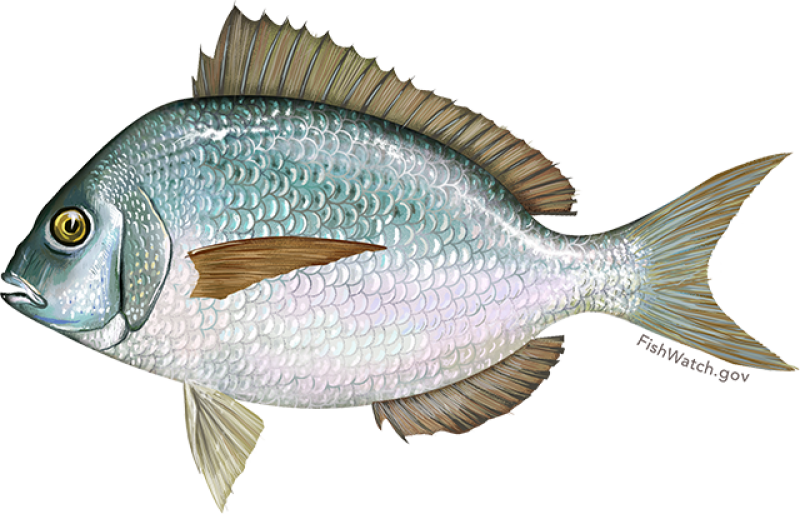Scup
The scup fishery in the U.S. operates from Maine to Cape Hatteras, North Carolina. Scup undergo an extensive migration between coastal waters in the summer and offshore waters (outer continental shelf) in winter. They migrate offshore and south in the fall, returning north and inshore to coastal areas and bays in spring. The scup fishery predominantly uses trawls or handlines, but other gear includes longline, rod and reel, pot, trap, gillnet, spear, and dredge. The market for scup is for human consumption. U.S. wild-caught scup is a smart seafood choice because it is sustainably managed and responsibly harvested under U.S. regulations. Implementing regulations are found at 50 CFR part 648 subpart H.
Population
Above target population level in the Mid-Atlantic/New England.
Fishing Rate
At recommended level.
Habitat Impacts
Otter trawls can impact bottom habitat. Scup are mainly harvested over sand and mud habitats, which appear to be more resilient to the effects of trawling than more structured habitats, such as coral.
Bycatch
Regulations are in place to minimize by catch.
Population Status
There are two stocks of scup: Mid-Atlantic/New England and South Atlantic. According to the most recent stock assessments:
The Mid-Atlantic/New England stock is not overfished and not subject to overfishing.
In the South Atlantic, scup is contained in the South Atlantic Porgy Complex. Scientists have not assessed the Porgy Complex, so the population status is unknown.
With greatly improved reproduction and survival rates and low fishing rates since 1998, Mid-Atlantic spawning stock biomass (a measure of the amount of scup able to reproduce) has steadily increased since the mid-1990s.
Appearance
Scup are deep-bodied (deeper from back to belly than they are wide).
They are dusky brown with bright silvery reflections below and spiny fins.
Adult fins are mottled with dark brown, and young scup fins may be faintly barred.
Scup’s front teeth are very narrow, almost conical, and they have two rows of molars in the upper jaw.
Longspine porgy look similar to scup, but can be easily identified by the elongated spines on their backs.
Biology
Scup grow slowly, up to about 20 inches long and 4 pounds.
They can live a relatively long time, up to about 20 years.
Scup are able to reproduce when they reach age 2, when they’re about 8 inches long.
They spawn over weedy or sandy areas in southern New England from Massachusetts Bay south to the New York Bight from May through August, with peak activity in June.
Individual scup spawn once a year.
Most fish spawn at night, but scientists believe scup spawn in the morning.
Females release an average of 7,000 eggs, which are fertilized externally.
Scup are browsers – they nibble on invertebrates that live on the ocean bottom.
They are able to grasp food with their incisors and crush hard-shelled animals with their strong molars.
A variety of plankton-eaters—such as medusae, crustaceans, and fish—prey on scup larvae.
A number of fish and shorebirds prey on juvenile and adult scup.
Where They Live
Scup are found in the Northwest Atlantic Ocean, primarily between Cape Cod, Massachusetts, and Cape Hatteras, North Carolina.
Article by: NOAA

